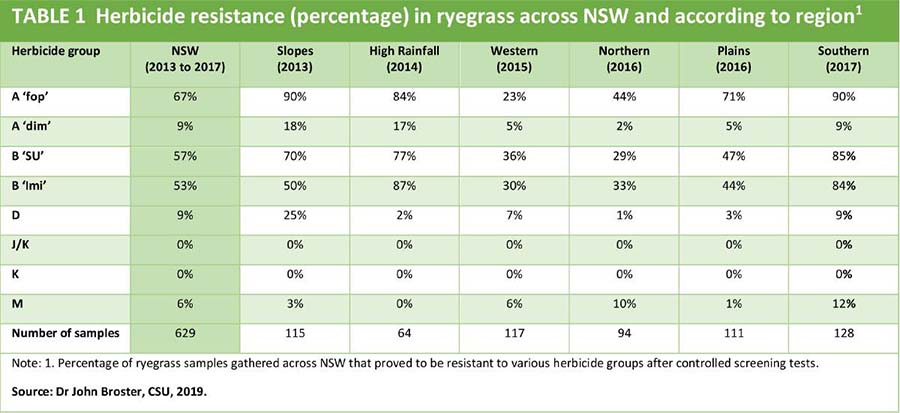New survey results have re-ignited calls to use as many non-herbicide weed management tactics as possible to delay the onset of herbicide resistance.
Charles Sturt University senior technical officer Dr John Broster, from the Graham Centre for Agricultural Innovation, and Dr Adam Jalaludin, from the Queensland Department of Agriculture and Fisheries (DAF), recently completed the first herbicide resistance survey of the entire northern grain growing region (New South Wales and Queensland).
The results reinforce the need for integrated weed management to prolong the effective use of available herbicides.
"Herbicide resistance was found in most major weed species, with high frequencies of resistance to Group A and Group B herbicides in randomly collected ryegrass populations in NSW," Dr Broster says.

Ryegrass was only found in NSW so the herbicide resistance screening results for ryegrass (Table 1) apply only to NSW populations.
"Worryingly ... what we found was that ... Roundup® (glyphosate) resistance in ryegrass ... in northern NSW was 10 per cent and south of Wagga Wagga towards the Victorian border it was 12 per cent," Dr Broster says.
In these regions, he says more ryegrass populations were resistant to glyphosate than to the Group A herbicide clethodim.
Dr Broster says this means growers with confirmed glyphosate resistance who wish to plant summer crops and fallow paddocks during winter will have to rely on alternative knockdowns.
But the good news according to Dr Broster is that every weed species still has some herbicides that work on all sample populations (Table 1).
Nonetheless, he warns against relying on one herbicide group alone because it hastens the development of herbicide resistance.
"We've got to maintain the herbicides that work by using non-herbicidal weed management tactics, in conjunction with our herbicides, to ensure their effective life for as long as possible."
Scorecard
Dr Broster says the random survey showed 67 per cent of NSW ryegrass samples were resistant to Group A ('fop') herbicides.
In addition, significant levels of resistance were found to Group B sulfonylurea ('SU') and imidazolinone ('imi') herbicides with more than 50 per cent of populations affected.
Less than 10 per cent of ryegrass samples were resistant to 'dim' and Group D herbicides; and only six per cent of ryegrass samples were resistant to one or both of these herbicide chemistries.
No ryegrass samples from the NSW survey were resistant to Group J or K herbicides.
Similar variations in the extent of resistance were recorded for all other herbicides screened.
Other weeds
The same survey also randomly collected other weed species from NSW for herbicide resistance testing (Table 2).

The results showed a significant number (38 per cent) of wild oat populations were resistant to the Group A 'fop' herbicides and 54 per cent of sow thistle populations surveyed from central and southern NSW were resistant to Group B 'SU's.
With the exception of sow thistle, Dr Broster says all populations of the weed species surveyed were susceptible to one or more herbicides.
As a consequence, he says it is critical to maintain the efficacy of herbicides by using non-herbicidal weed management tactics such as crop competition, crop rotation and some form of harvest weed-seed control.
In the north
In northern NSW and Queensland, Dr Adam Jalaludin from DAF gathered samples of fleabane, awnless barnyard grass, feathertop Rhodes grass and sow thistle for herbicide resistance screening.

His research (Table 3) to date shows:
- resistance to the Group M herbicide glyphosate was found in 98 per cent of fleabane samples, 70 per cent of feathertop Rhodes grass samples, 35 per cent of awnless barnyard grass samples and 18 per cent of sow thistle samples;
- no resistance to the Group I herbicide 2,4-D was detected in fleabane or sow thistle samples.
Dr Jalaludin's work is ongoing and additional samples will be screened in future to a wider range of herbicides.
More information: Dr John Broster, 0427 296 641, jbroster@csu.edu.au; Dr Adam Jalaludin, 07 4529 1346, adam.jalaludin@daf.qld.gov.au

























































